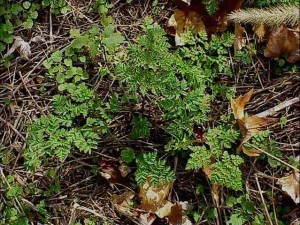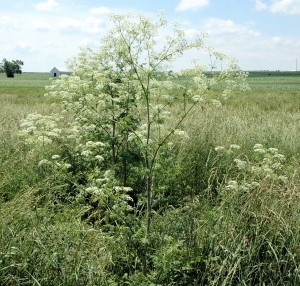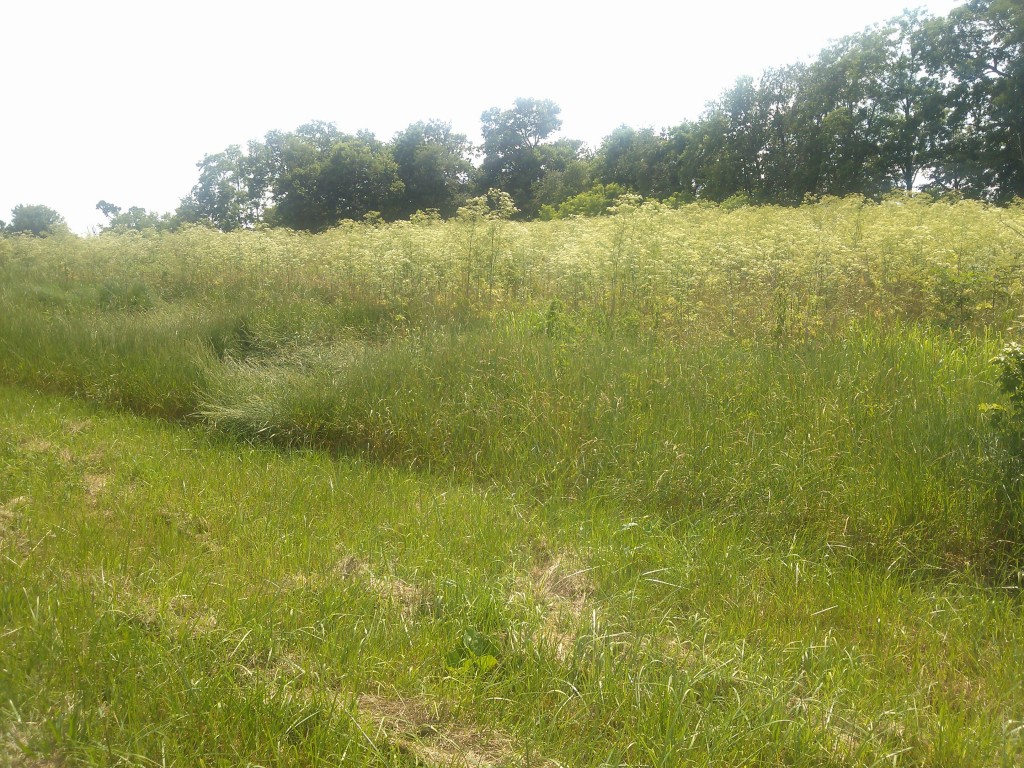– Stan Smith, OSU Extension PA, Fairfield County
As described regarding cressleaf groundsel by Mark Loux last week in this publication, and as is the case with nearly all biennial or perennial weeds, late fall is a great time to control poison hemlock. There are a couple of good reasons but perhaps the best is that while those plants are presently storing energy in their root systems to survive the winter, it is also a time when herbicide is very easily transferred into that root system. The ability to more effectively use 2,4-D or similar products to kill broadleaf plants now, eliminates the possibility of killing desirable grasses such as when a glyphosate based product is used, thus maintaining desirable competition helping to prevent future broadleaf weed invasions. Another advantage is with few gardens or annual flower beds still in tact, fall also provides an opportunity to utilize chemical broadleaf killers that have been known to volatilize when used in the spring, killing or severely damaging sensitive garden and landscape plants.
That being said, if you identified locations this past spring where poison hemlock was growing, it’s likely new plants will be emerging there soon if not already. Scout those locations from now until freezing temperatures shut the plants down for the winter, and treat them with broadleaf killers such as 2,4-D, dicamba or Crossbow.
For those who may have missed the article in this publication earlier in the summer regarding poison hemlock, below is an article from our friends at the University of Kentucky that was first published in July of 2015.
Be Aware of Poison Hemlock – Michelle Arnold, DVM (UKVDL) and J. D. Green, Ph.D. Extension Weed Scientist, University of Kentucky
Poison hemlock is toxic to a wide variety of animals including man, birds, wildlife, cattle, sheep, goats, pigs and horses. People are usually poisoned when they mistakenly eat hemlock for plants such as parsley, wild carrot or wild anise. The first notable example of human poisoning was the death of Socrates in 399 B.C. when he ingested a tea made from poison hemlock containing the toxic piperidine alkaloids coniine and gamma coniceine.
Cattle seldom eat hemlock but they will if no other forage is available or it is incorporated in hay or silage. A question commonly asked is how much do cattle need to eat to kill them. Unfortunately, the answer is not clear cut. The toxic alkaloid content varies considerably of the plant depending on stage of growth, season, moisture, temperature, time of day, and geographical region (southern plants are more toxic than northern plants). The conium alkaloids have two major effects: 1) rapid, sometimes fatal effects on the nervous system and 2) they are teratogenic agents (causing birth defects in calves and pigs). Cattle have died by eating as little as 0.2-0.5% of their body weight in green hemlock. Poison hemlock is teratogenic if it is eaten by a cow in the first trimester of pregnancy.
During the past months the evidence of poison hemlock (Conium maculatum) is widespread. Although this plant is often seen along roadways, abandoned lots, fencerows, and other non-cropland sites, in more recent years, it has expanded out into grazed pasture lands and hay fields. Poison hemlock is classified as a biennial that reproduces only by seed. It is capable, however, of completing its lifecycle as a winter annual in Kentucky if it germinates during the fall months. Flowers and new seed are typically produced in late May and June. Plants emerge as a cluster of leaves that form a rosette. Poison hemlock is most noticeable at this stage of growth in late fall through early spring with its parsley-like leaves which are highly dissected or fern-like (Figure 1). The individual leaves are shiny green and triangular in appearance.
As the plant begins to send up flower stalks, the leaves are alternately arranged on the main stem. Each individual leaf is pinnately compound with several pairs of leaflets that appear along opposite sides of the main petiole. As the plant matures, poison hemlock can grow upwards to about 6 to 8 feet tall (Figure 2). At maturity the plant is erect, often with multi-branched stems, and forming a deep taproot. Poison hemlock has hollow stems which are smooth with purple spots randomly seen along the lower stem that help distinguish it from other plants similar in appearance. The flowers, when mature, are white and form a series of compound umbels (an umbrella-shaped cluster of small flowers) at the end of each terminal stalk. Although poison hemlock is often associated with areas that have moist soil conditions, it can also survive in dry sites.
All classes of livestock are known to be affected by poison hemlock. Cattle, horses, and goats are considered to be the most susceptible domestic animals although other animals can be affected as well. Symptoms of poisoning can occur rapidly anywhere within 30 minutes to 2 hours depending on the animal, quantity consumed, and other ecologic factors. Toxicity varies depending on stage of plant growth, location and environment. Poison hemlock foliage has an unpleasant mouse urine-like odor, detectable when near the plant or when a stem or leaf is crushed. Livestock generally avoid it unless forage is scarce but it may be accidently consumed as a contaminant of hay or silage. Poison hemlock contains 8 piperidine alkaloids; the two major ones are coniine (major alkaloid in the seed) and gamma-coniceine (predominate in green, vegetative growth). These alkaloids cause paralysis of the muscles by acting as a neuromuscular blocking agent. Signs of acute poisoning include:
- Nervousness, trembling, muscle weakness, incoordination
- Salivation (slobbering)
- Initial stimulation or excitement followed by depression
- Dilation of the pupils
- Weak heartbeat
- Musty, mousy odor to breath and in the urine
- Prolapse of the third eyelid across the cornea may cause temporary blindness
- Death by respiratory failure due to paralysis of respiratory muscles
Although acute disease is a primary concern, an equally serious problem is subacute intoxication of pregnant livestock that causes deformed bones and joints in calves and pigs. The plants must be eaten for an extended period of time during the first trimester of pregnancy. The susceptible stage of gestation for maternal exposure for cattle is from 50-75 days for skeletal defects to occur. These alkaloids continuously reduce fetal movement during tissue formation, resulting in crooked legs, deformed necks and spines. Less commonly, cleft palate results from lack of fetal movement in the head and neck regions at 30-50 days gestation, resulting in the tongue preventing normal palate closure during embryo development.
Fortunately most animals tend to avoid grazing poison hemlock if other forage is readily available. However, animals may be more prone to consume green plants during the late winter and early spring when other forage species are limited. All parts of the plant, including the seeds, are considered to contain the toxic principles coniine and gamma coniceine. Gamma coniceine is considerably more toxic than coniine and is at its highest concentration in early growth. Ingestion of fresh, green plant material may quickly produce signs of intoxication within an hour and last for several hours. As the plant matures, gamma coniceine is reduced (chemically changed) to the less toxic alkaloid coniine. Seeds and dried plant material contain the highest concentrations of coniine. Toxicity may be somewhat reduced in dried plants due to volatility of the alkaloids, but the potential for toxicity still exists, particularly when a sufficient quantity is consumed in dried hay. Seeds are highly toxic and can be a source of poisoning when they contaminate cereal grains fed to livestock. Therefore, extreme caution should be considered before feeding animals hay or grain known to contain poison hemlock.
Diagnosis is based on history of plant ingestion, clinical signs and chemical analysis for presence of alkaloids in rumen contents. No specific treatment for poisoning exists. If acute poisoning does not progress to respiratory failure and death, the prognosis for full recovery is good. Avoid overexcitement and stress that may exacerbate clinical signs and result in death.
Public health is a concern when dealing with poisoned animals because of the possibility of alkaloid residues in meat. Elimination of plant toxicants through the milk is a minor route of excretion but may be important when consumed by a calf or a human.
The principle strategy for poison hemlock control is to prevent seed production which can be a challenge since a fully mature plant is capable of producing 35,000 – 40,000 new seeds. It is too late to utilize herbicide control methods after plants have produced flowers. Therefore, mechanical control efforts (if feasible) such as mowing or cutting down individual plants should be initiated just before peak flower production to avoid or reduce the amount of new seed being produced. Make note of areas heavily infested with poison hemlock (Figure 3) and begin to look for emergence of new plants in the fall. During the late fall (November) or early spring (March) is the best time of year for herbicide treatment. In grass pastures and hayfields herbicide products containing 2,4-D can be effective when applied to young, actively growing plants that are in the rosette stage of growth. Spot treatments with products containing 2,4-D, triclopyr, or glyphosate can also be used depending on the location.


